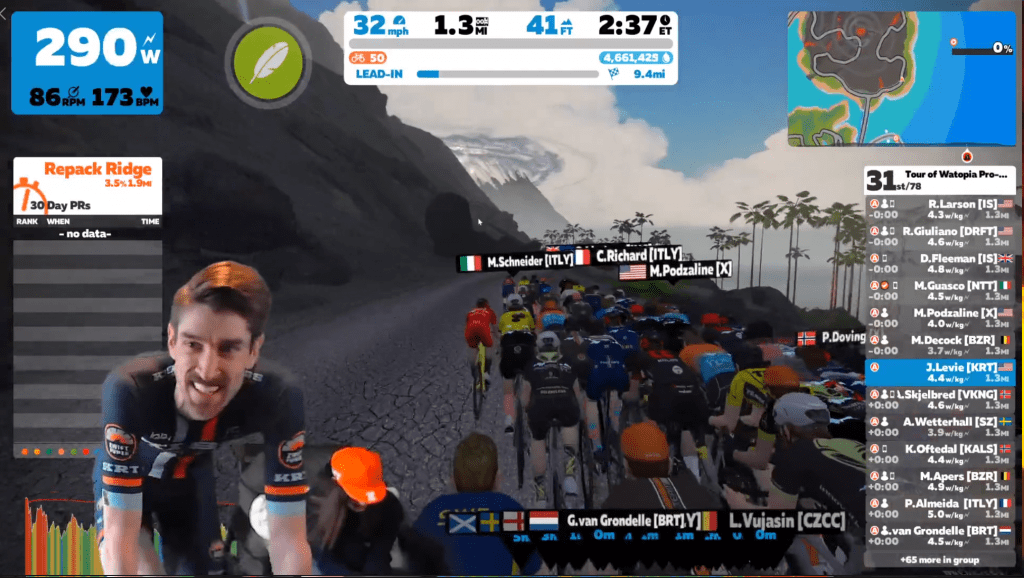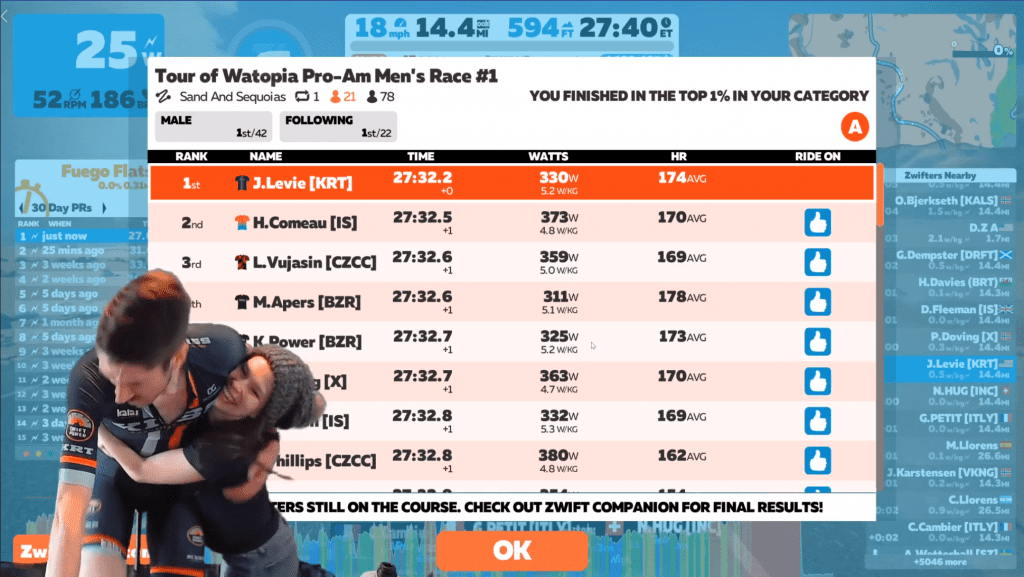After some hard-fought battles the Tour of Watopia 2020 Pro-Am invitational series is all wrapped up. This was a points-based race series organized by Zwift, featuring a mix of the world’s top pro and community indoor teams.
While many expected the men’s winner to come from one of the more heavily-stacked teams, Zwift community fixture Jonathon Levie of ZwiftHype fame pulled off the victory. Let’s hear from our yellow jersey winner and get more insight into what it takes to come out on top in a race series of this caliber.
ZI: First question: you just won the big Tour of Watopia Pro-Am series! Congratulations. What does it feel like?
JL: Unbelievable! There’s such a strong lineup of riders invited to these events that I wasn’t expecting this!
Are you a celebrity in game now?
After I won Stage 1, I had a flood of notifications from new followers on the Companion app!
Tell me about your background in cycling and Zwift. How did you get to where you are today?
Before Zwift, I had a pretty regimented training schedule, with some weeks up to 25 hours. When we found Zwift early 2017, my wife Katie and I were both instantly hooked. We actually bought AC so we could stay inside when the weather was nice!

This was an invitational race series. When did you get the invite, and did you begin training specifically for the series after that? What did your preparation look like?
The invitations are always a surprise, and so training for these events is very different than a typical race schedule. We need to maintain top fitness throughout the year to be successful.
You ride for KISS Racing Team (KRT). I think it’s fair to say that most people didn’t expect the winner to come from KRT when you were going up against “pro” teams like Canyon ZCC and Indoor Specialist. Was that intimidating at all? How did you approach that strategically?
We’ve had success in the past through Tim Cartwright, so I’m trying to live up to those past achievements he set for our team.
What’s convenient with Zwift racing is we have the ability to see data history for other riders, know where we stand performance-wise, and plan around that. However, it’s not all about putting out big numbers. As you can see through watching the pro riders that join our events, there’s a certain Zwift craft that needs to be learned to succeed here.
Absolutely. There’s a lot more to Zwift racing than pure power! What sort of skills/knowledge (outside of pure fitness) did you find most useful in these races?
Learning to draft is key! I’d recommend hopping into an event the uses #doubledraft to see how important this is. There’s a weekly series I’ve been doing that combines all categories together and utilizes this double-draft setting. In that race, the B’s, and some C’s, can make it all the way to the sprint finish with our front A group. The double draft is so strong, they can even work together to pull A+ riders back that are trying to break away!
Most Zwift races use normal drafting settings, but what you learn through doing double-draft events can be applied. It’s interesting to see these pro riders work their way to the front of the pack and take monster pulls, as they’re just providing draft to the resting pack. At best, their pulls will shed a few weaker riders that were already on the edge of dropping.
When it comes to drafting at the front, if you’re overlapping wheels with the person who’s pulling the pack, then you’re also putting your nose in the wind. The best time to push is when the road tilts up, but even uphill there’s a draft, and you’re also a carrot to chase. Learning how to surf the pack is key to making to the sprint, and double draft events emphasize this.
This was a points-based series, not just a series of scratch races. Points were available mid-race at sprint and KOM markers, as well as at the finish line. How did this change your approach to each event?
With the points structure, it’s a very animated race. Normally we don’t see breakaways, so this format expands a single race into a handful of back-to-back mini-races. Saving everything for the end doesn’t pay off, you have to dig deep and recover quickly to come out on top.

Because of your high placings in this series, I’m sure you got to work with ZADA to verify that your power numbers were accurate. What was that experience like?
With ZADA, it’s exciting to get confirmation that you’re doing everything correctly, but we actually don’t find out their results until they are posted for everyone. I assume if something was off, they’d continue to work with you to solve the issue, as they want riders to continue to race.
As I don’t have much outdoor data from the past 12 months, just some social rides with the wife, I did a series of tests for ZADA between stage 1 and 2 for verification. Actually, I ended up injured from it, so stage 2 and 3 I tried my best to hang on to my lead. In the future I’ll briefly head outdoors for some prominent KOMs, so I won’t need to do last-minute verification testing.
That’s a good lesson for anyone racing in these top-tier races, and one I’ve heard from ZADA themselves. Have your power numbers on file and ready to provide to ZADA before they ask for them!
You got to wear the yellow jersey for the last two races, as series leader. Do you get to keep it? Were there any other prizes (cash, smart trainers, in-game kits) associated with the series?
From what I heard on the broadcast it’s mine to wear around, so keep your eyes out for some happy yellow pixels riding around Watopia.
Shoot, I actually had to repeat all of our Men’s Pro-Am stages to unlock the sweet Tour de Watopia jersey, since our races don’t count towards completion, and that’s really what I was aiming for. But yeah, there was also money, which I found out after Stage 1.

What do you have planned next in terms of bike racing?
Actually, the month before our Tour de Watopia race I did my first vEverest. It was 11 hours and 2 minutes. TWO minutes. It could have been 10 hours 2 minutes, or 12 hours and 2 minutes, but either way I want to chip those two minutes off.
The payoff is the ability to eat non-stop throughout the whole day, and I’d like to fit that in before the next invitational race announcement.
Anything else you’d like to add or share?
My team was very supportive, and we worked together to make it happen. We needed a minimum number of riders capable of committing to the time slots, so we brought in B riders who put themselves out there live. Their goal was to hang on as long as possible out of the pens, which was about a minute.
For the jungle event, one of our B riders had a goal of making it to the front of our MTB pack on the paved section, so he chose a road bike and sprinted through the group, barely making it up there and actually nabbing some camera time. As soon as we hit the dirt though, the rolling resistance difference made it appear as though he pulled a parachute, but he had his own victory.
Congrats on your win, Jonathon. See you out on course!

